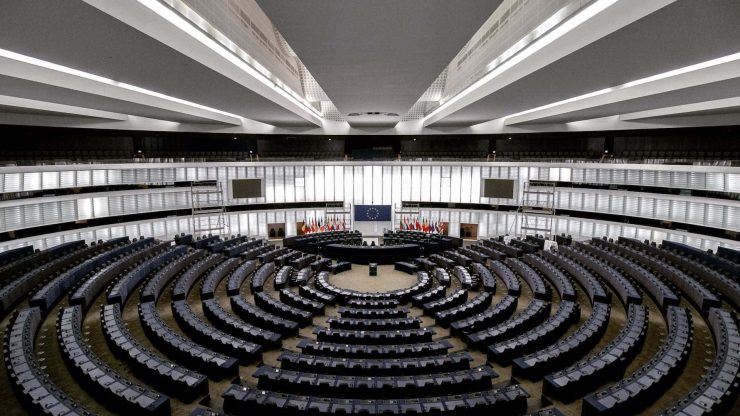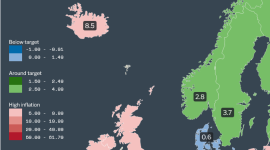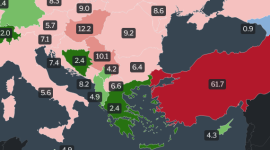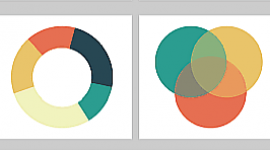Introduction and turnout at EU elections in Croatia
Croatia is the EU’s newest member joining the Union on July 1, 2013. For the third time in six years, elections for the European Parliament took place in Croatia. EU elections in Croatia brought increased voter turnout and several surprises.
Voter turnout was better than in previous years. Out of 3,696,907 eligible voters, 1,103,551 voted. Making for 29.86% national turnout.
In 2014, voter turnout was lower at 25.12%, with 950,980 voters participating in the election process. The total number of eligible voters was still well above 3 million at 3,767,343 voters. As a result, voter turnout was among the lowest in the European Union. Only Slovenia (24.55%), Poland (23.83%), and Slovakia (13.05%) had lower turnouts.
This increased turnout in 2019 seemed to follow a trend in the EU in general. In the EU, as a whole, 50.95% of citizens voted – marking it the highest participation in the last 20 years – up by 8.34% since the previous elections in 2014.
Turnout per cities and municipalities
Noticeable regional differences characterized this election in Croatia. While the overall turnout was higher, this average does not paint a complete picture.
The highest turnout was recorded on the Island of Mljet, with 56.57% of registered voters (616 out of 1089) casting their ballots. On the flip side, the lowest turnout was recorded in Štitar, with only 13.67% of voters (257 out of 1880) giving their votes. Interestingly, the second lowest turnout was recorded in Gunja municipality, fairly close to Štitar, both in the Slavonia region of Croatia.
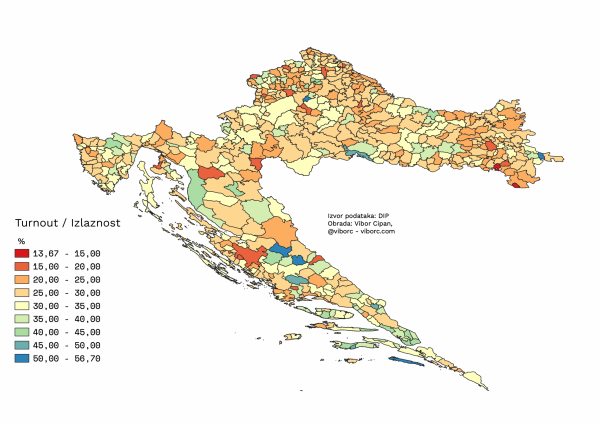
Highest turnout
| Municipality | Turnout % | Voters | Eligible voters | County | Winner |
|---|---|---|---|---|---|
| Mljet | 56.57 | 616 | 1,089 | Dubrovnik-Neretva | HDZ |
| Rakovec | 56.39 | 547 | 970 | Zagreb | M. Petir |
| Ervenik | 55.82 | 417 | 747 | Šibenik-Knin | SDSS |
| Lovas | 51.12 | 480 | 939 | Vukovar-Srijem | HDZ |
| Biskupija | 51.04 | 665 | 1,303 | Šibenik-Knin | SDSS |
Lowest turnout
| Municipality | Turnout % | Voters | Eligible voters | County | Winner |
|---|---|---|---|---|---|
| Štitar | 13.67 | 257 | 1,880 | Vukovar-Srijem | HDZ/EPP |
| Gunja | 14.46 | 469 | 3,243 | Vukovar-Srijem | HDZ/EPP |
| Donja Voća | 15.34 | 321 | 2,093 | Varaždin | Reformisti |
| Civljane | 16.46 | 39 | 237 | Šibenik-Knin | SDSS |
| Polača | 16.75 | 266 | 1,588 | Zadar | HDZ |
EU elections in Croatia – the results
Croatia has 11 seats in the EU parliament – a number that will grow to 12 once the UK finally leaves the Union.
HDZ and SDP win most of the seats
The ruling center-right party, HDZ (Croatian democratic union/Hrvatska demokratska zajednica), won the majority of the popular vote with 244,076 votes (22.72%) – giving it four seats. To a much surprise, the main opposition party, center-left SDP (Social-democratic party/Socijaldemokratska partija), won the same number of seats with 200.976 votes (18.71%). Most pre-election polls gave SDP three spots – with only two surveys by 2×1 komunikacije (one on April 30 and the other from May 23) predicting them four seats. While the HDZ’s result is considered a failure (the party expected at least 5, possibly even six places), SDP greeted its four seats with a surprisingly good result. Notably, in 2014 elections, SDP secured only two seats in the EU parliament.
Croatian Sovereignists win one; MOST disappoints with zero
The Croatian Sovereignists (Suverenisti) coalition (right-wing) won 1 place with 91,546 votes (8.52%). Their success was also somewhat unexpected – at least according to polls. Out of 20 surveys (from November 23, 2018, until May 24, 2019), only 8 of them gave one seat at the EU parliament. For comparison, a widely expected place for MOST (Bridge of Independent Lists) never materialized. Although, 19 out of 20 polls predicted them to win one place.
Kolakušić surprises the public, Živi zid and Amsterdam Coalition tied with one seat won
Probably the biggest surprise was the result of Mislav Kolakušić‘s independent list. A former judge running as an independent received 84,765 votes (7.89%) – enough for one place in the EU parliament.
Human Shield (Živi zid), a syncretic, populist, anti-establishment party, came in fifth winning 60,847 votes. That is just above the national threshold of 5% – winning 5.66% votes and a single place in the EU parliament. All polls predicted them to have at least one seat – with 5 out of 20 predicting the two positions.
Lastly, Amsterdam Coalition (Amsterdamska koalicija) tallied 55,806 votes (5.19%) in barely winning their seats.
Results of EU elections in Croatia per municipalities
The following map depicts the results for all Croatian municipalities.
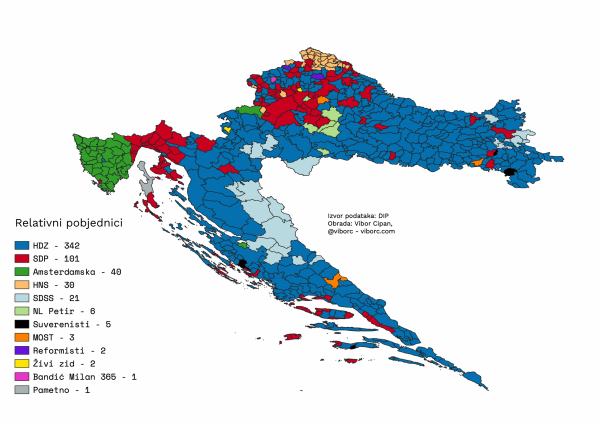
Summary of 2019 EU election results in Croatia
| Party/Coalition | EU party | Popular votes | % | Seats won |
|---|---|---|---|---|
| HDZ | EPP | 244,076 | 22.72 | 4 |
| SDP | PES | 200,976 | 18.71 | 4 |
| Sovereignists | ECR/ECPM | 91,546 | 8.52 | 1 |
| M. Kolakušić | NI | 84,756 | 7.89 | 1 |
| Živi zid | EFDD | 60,847 | 5.66 | 1 |
| Amsterdam Coalition | ALDE | 55.892 | 5.19 | 1 |
| MOST | - | 50.257 | 4.67 | 0 |
| M. Petir | EPP | 47.358 | 4.40 | 0 |
| NHR-HSP | - | 46.970 | 4.37 | 0 |
| SDSS | - | 28.597 | 2.66 | 0 |
Compare elections results and voter turnout
Interactively explore the map of Croatia. Compare turnout rates with the election results down to the municipality level. Just drag the slider left or right and have fun.
[twenty20 img1=”129″ img2=”117″ offset=”0.5″ before=”Turnout” after=”Winners”]
Conclusion
With turnout reaching an all-time high for Croatia’s EU elections (at 29.86%), Croatia joined the general EU trend of increased turnout for the 2019 EU Parliament elections.
Two major parties, HDZ (EPP, center-right) and SDP (EPS, center-left), won four seats. Most polls suggested three places for SDP and five, or even, six seats for HDZ.
Read our in-depth analysis of the HDZ vs. SDP election results rundown.
MOST was not able to gather enough votes for a single seat, while two surprises – “Suverenisti” and M. Kolakušić – each earned one position in the EU parliament. Anti-establishment and syncretic party Živi zid won one place, same as Amsterdam Coalition (ALDE, liberals).
ABOUT THE AUTHOR
